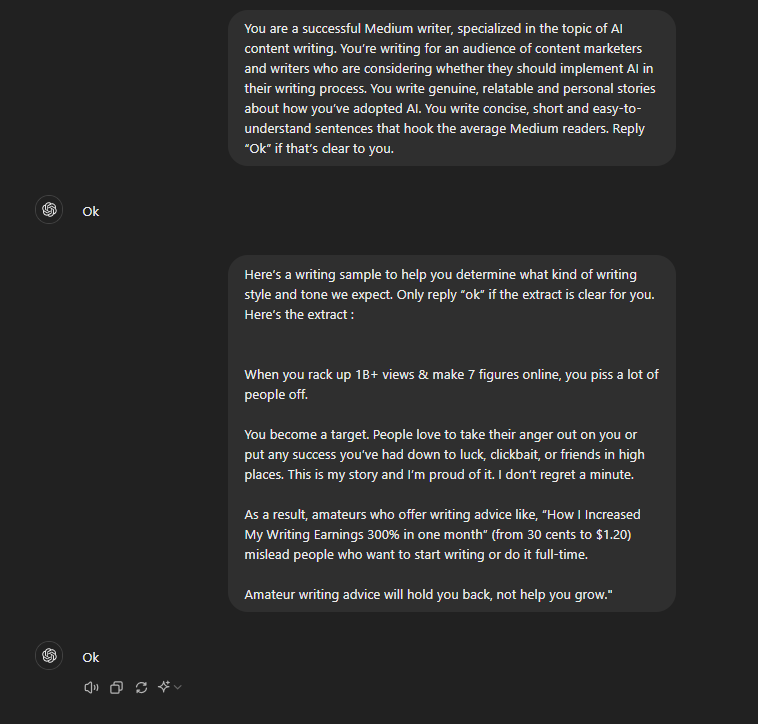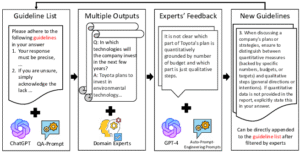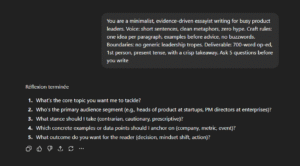ChatGPT’s efficiency is very tempting for writers, but there is a big catch :
How would you accept to publish a piece that doesn’t sound like you?
Thankfully, there is a way to teach ChatGPT to write like you. This guide will show you how through specific prompting techniques.
The Limitations of the Generic Tone of ChatGPT

LLMs like ChatGPT or Claude are machines designed to spit out the most likely words and phrases. They say only what people want to hear.
That’s precisely why their output can sound so bland and uninteresting. The models draw from a vast, generalized dataset, which may not always align perfectly with a specific style or subject matter. That’s not all.
You might also notice that ChatGPT’s text feels repetitive. The AI often falls into patterns, using similar phrases and structures across different pieces of content. This can make your articles sound monotonous and predictable.
As a result, your content’s engagement level can suffer due to the generic tone. Readers today expect content that is not only informative but also engaging and relatable. They want to hear from strong expertise and characters and learn about personal stories and experiences.
But there’s a way to make your AI content reflect your own personality and style.
Teaching ChatGPT to write like you: a 5-step process
I’ve spent much time finding the right way to prompt ChatGPT to make it sound different. Here are 5 techniques I’ve found:
#1 Give it specific editorial guidelines

To make ChatGPT write like you, start by giving it clear and specific editorial guidelines.
First, outline the key elements of your writing style. Think about your voice, tone, and the structure you use in your content. Are you conversational or formal? Do you prefer short sentences or more complex structures? Identify these traits clearly.
Next, translate these traits into specific guidelines for ChatGPT. Use a prompt like this:
Each time you’re writing something, follow this step-by-step guideline:
- guideline 1
- guideline 2
- guideline 3
Reply ‘ok’ if that’s clear for you.
You can add this prompt in ChatGPT’s custom instructions feature. This tool allows you to add background information and requirements that ChatGPT will consider whenever it generates a response.
Be mindful of the AI’s internal system messages, which can sometimes override your instructions with default settings. To counter this, make your guidelines explicit and emphasize that they should take precedence over any default behaviors.
#2 Provide a meaningful sample

More than following guidelines, LLMs are especially good at imitating writing styles.
When they analyze your writing they learn to recognize your sentence structure, tone, and the specific words and phrases you commonly use
So to make it write like you, you might provide a meaningful sample of your writing.
Choose a piece of your work that showcases your tone, whether it is an extract of one of your blog posts, social media updates, or professional articles.
You can use this prompt to share your writing sample:
Here’s a writing sample to help you determine what kind of writing style and tone we expect. Only reply ‘ok’ if the extract is clear for you. Here’s the extract: [insert writing sample].
#3 Add your ideas

Style is not enough. You also need to infuse LLMs with your own ideas and insights.
You want to incorporate your subject matter expertise, personal experiences, and unique viewpoints.
Begin by gathering your own notes, drafts, and any other materials that showcase your original thoughts and ideas on a topic. This could include lessons learned from your experiences, insights from your professional background, or findings from your research.
Then use this prompt for your AI to get inspired by your ideas:
Give me an outline about [your subject] based on this first draft of ideas: [insert your draft]
You can also use transcripts of speeches or recorded conversations where you discuss relevant topics.
#4 Build an outline

Prompt engineers praise “chain-of-thought” prompting.
That’s what an outline basically is. It serves as a roadmap to ensure ChatGPT’s ideas are on the right track.
So you should start by asking ChatGPT to outline the main sections and key points you want to cover in your content. This could include an introduction, several body sections, and a conclusion. Each section should have specific subpoints that detail the ideas you want to convey.
You should proofread the outline before generating the content section-by-section. Once you have your outline, give it this prompt:
Based on the following outline and previous guidelines, write section 1. of the content in 300 words
The defined length enables you to control the level of detail of each section.
#5 Reinforce your guidelines

It’s sad, but LLMs won’t achieve your desired results in one go. They will often forget parts of your guidelines throughout the process.
To get closer to your ideal output, you need to reinforce your editorial guidelines, sometimes several times.
So when you are unsatisfied with ChatGPT writing, provide clear and specific feedback. Here’s an example of how to provide feedback:
Rewrite this section with a structure that doesn’t feel repetitive with the other sections/ with concrete arguments/actionable recommendations/
Rewrite the post with a less predictable structure and add pattern-interrupt elements to keep readers engaged
Rewrite the post to be more concrete and straightforward. Focus on clear, actionable insights
Rewrite the post with a more engaging hook and ensure it maintains a conversational tone. and avoid abstract language.
Such feedback helps ChatGPT understand your preferences more deeply and adjust its future outputs accordingly.
Additionally, it helps introduce variety into the writing to keep it engaging. Encourage ChatGPT to use different sentence structures, include bullet points, and vary paragraph lengths.
This approach humanizes the content and makes it more likely to bypass AI detectors.
Try these prompts and tell me how they work for you !






